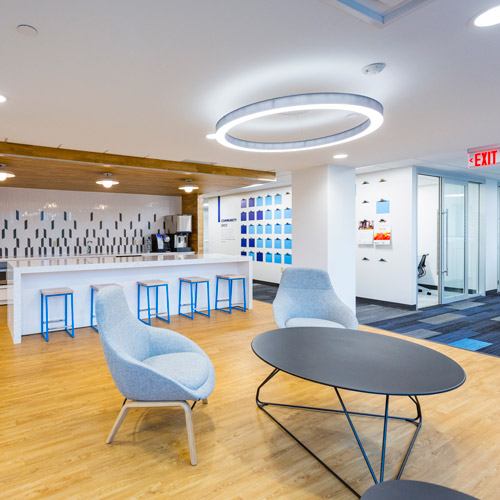When they said, ‘If you can make it in New York, you can make it anywhere,” they failed to mention that finding real estate is an entirely different matter. Video game juggernaut Take-Two Interactive had to learn this firsthand. Not long ago, as one of the fastest-growing companies in its industry, putting out some of the biggest titles in the gaming world—Grand Theft Auto, Civilization, NBA 2K, and BioShock, among others—it found itself rapidly outgrowing its Soho headquarters.
Enter Larry Charlip. The senior director of facilities and real estate management and his team were tasked with finding an optimal new office space for the company. Unfortunately, because of real estate constraints, that meant moving it out of its neighborhood—where Take-Two felt at home both in terms of aesthetic and company culture—and into a new space at 1133 Avenue of Americas, in the heart of Midtown.
It’s a far cry from Soho and maybe the last place you’d expect to find a video game company. “We set out on a mission to find a space that worked for us both from a space perspective and also from a commuting perspective for our employees,” Charlip says. “We centered around the Bryant Park area of Midtown, which is beautiful. But, as most people know, a lot of banks and law firms are in this area. Bank of America is right next door to us.”
Charlip knew the new location would be a hard sell to employees and was intent on proving that wherever Take-Two was located, it could feel like home. To him, that meant “it needed to be cool.”
An initial benefit Charlip saw in the new space was a private entrance for employees and guests alike. “Our employees don’t have to walk through a lobby if they don’t want to and their entrance is off on a side street,” he says.
Design partner Design Republic conceptualized the actual layout of the new space, and Charlip says it exceeded all expectations. The space largely consists of metal, steel, concrete, and wood, which, along with polished concrete flooring, establishes a chic industrial vibe. “Together with Design Republic, our engineers Robert Derector Associates, our general contractor SPK Lewis, and our project manager Bob Cottrell, we were able to deliver a space that our employees enjoy working in,” Charlip says.
The work wasn’t nearly as simple as it sounds, though. Take-Two took input from all its departments seriously, and that meant a longer design process than Charlip was used to, despite his extensive facilities experience. “We kept hearing from our employees that they wanted height-adjustable workspaces, and one of the things I’m really proud of is that we were able to provide them,” Charlip says. “That’s quite an investment to put into a space that holds more than 200 people.”
However, when the departments were initially presented with models of the height-adjustable furniture, designed based on their feedback, reactions were mixed. So, Charlip maneuvered the budget to make modifications based on each department’s specifications. He says the whole process was an important learning experience. “Part of that process in asking people what they want is that they don’t necessarily know what that looks like in their head,” he explains.
Charlip also took employee requests for more collaborative work spaces to heart. Again, though, he had to plan for the worst and hope for the best. “Employees tell you what they need,” he says, “but when you design and build it, you never quite know, if you’ve never had it, if it’s going to work the way people imagined it in their heads.” Fortunately, the new collaborative spaces are now being used constantly for both eating and meeting, and Charlip considers them a huge success.
While some might find the process of trying to actualize others’ half-formed desires frustrating, Charlip enjoys approaching it as a challenge, and he’ll continue to do so as he tackles his next project: standardizing the tech across all of Take-Two’s facilities portfolio. “Being the facilities guy, I’m trained to consider form and function,” he says. “Give me a direction, and I’ll go build it. It forces us to be more creative and put the pieces of the puzzle together.”


